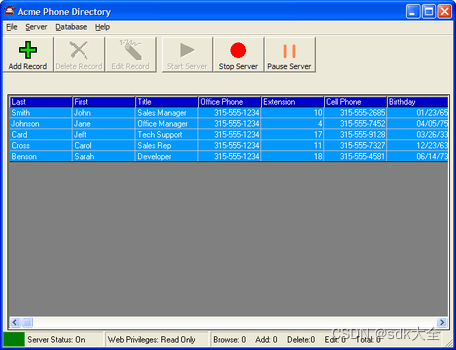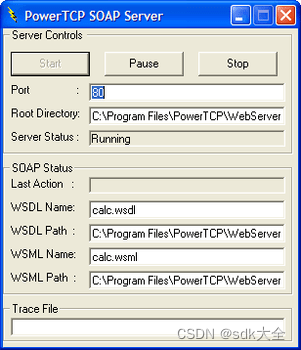PowerTCP WebServer for ActiveX Crack
About PowerTCP WebServer for ActiveX
Write a complete web application using your preferred development environment without having to use Microsoft’s IIS.

PowerTCP WebServer for ActiveX allows you to use Visual Basic, Visual C++, Delphi, C++Builder, or PowerBuilder to create your web application without having to learn ASP programming, Cold Fusion, or other web-based development environments. Features include: support for secure connections, support for cookies, automatic support for file uploads, faster application deployment, Request and Response objects and more.

PowerTCP WebServer for ActiveX: Enables a complete Web Application to be written in any Development Environment that supports ActiveX controls.
- Roytaly-Free Distribution
- Intuitive On-line Help
- WebServer
- Service
- NT Service Controls
- SMTP
- Request Object
- Cookie Object
- Session Object

Potential Web Applications:
- Develop forum software that allows visitors to share information
- Create internet applications generating streaming audio/video media
- Add a web interface to ANY existing application that needs to be monitored/controlled
- Construct a Web portal or search engine to share any information with the rest of the world
- Start with any existing client/server functionality, and publish this information using any HTML template
- Provide a configuration and control interface to any hardware product
- Easily build Intranet applications for any internal function
Sample Projects:
- Web Forum Web Forum, written by Dart's Technical Support staff, provides a message forum that incorporates email, technical articles and search capabilities
- Web Server A secure Web Server that can be configured to listen on any port
- Cookie Test Shows how to check for client-side cookie support, and how to set/read cookies on the client
- Web FAQ Shows how a simple DAO database can be interactively edited and used to display dynamic content
IIS Comparison
- Application object is superceded with your global variables
- ObjectContext object is superceded with direct access to MTS
- Server object is superceded with direct access to the environment
- Request object is replaced with Dart's improved Request Object
- Certificate Object provides more help determining the attributes of the client certificate
- PUT and GET requests are routinely handled by a convenient DartStream Object
- Full file support for "multipart/form-data" sent as part of a POST request
- Cookies Object provides parsing support for cookie values and sub-values
- Form data is parsed and presented as a collection of HttpVariable Objects
- Response object is replaced with Dart's improved Response Object
- Response Object is pre-filled with the default response
- Convenient DartStream Object makes it easy to respond with strings or files
- Enumerated Status property simplifies use, and pre-fills StatusText with default values
- Header is exposed as a collections, and default values are automatically used unless overridden by your code
- Session object is replaced with Dart's improved Session Object
- SessionInit and SessionEnd events support initialization and termination
- Session cookies automatically manage sessions
- HttpVariables Object supports use of any Variant for state management
Benefits & Features:
- The features of IIS on a single web server control
- Re-use your existing client/server code
- A single application can be developed for both global and local use
- Content can be constructed right in memory
- Secure connections are fully supported
- Applications can run on multiple ports
- Easily install and run your web app as an NT Server
- Complete support for managing cookies
- Easily manage files and buffers w/ Dart Stream Object
- File uploads are AUTOMATICALLY supported, so you don't need add-ins like FileUp.
- Apply the robust power of Visual Basic or any other development environment to the development of your web applications
- Listen on ANY port/address combination, so you can host multiple web applications on a single server
- Default operation is with requested web pages automatically sent unless you over-ride the default operation in the Get Event.
- Events fire as each GET, HEAD, POST, PUT or general request arrives...you just add processing code to the events you want to respond to.
- Deploy FAST applications by building responses in memory (bypass slow disk access).
- Deployment is a snap: just compile and build a normal distribution, install the compiled web application on your server, and optionally install it as a service
- Debugging is easy. You can easily set breakpoints within your application and exercise it from your workstation using any browser
- All events fire on a single thread for maximum throughput for light-to-medium loading
- For high loading, MTS and multi-threaded classes can be used for constructing lengthy responses on dedicated threads, allowing the main thread to freely operate
- Responses can be constructed entirely in memory, providing the fastest possible response times (single-threaded operation is fasted for light-to-medium loading)
- Multiple applications can be written and installed on separate address/port pairs, so large applications can be easily partitioned to run as any number of individual tasks, all on dedicated threads.
- Provide a configuration and control interface to any hardware product
本文来自互联网用户投稿,该文观点仅代表作者本人,不代表本站立场。本站仅提供信息存储空间服务,不拥有所有权,不承担相关法律责任。 如若内容造成侵权/违法违规/事实不符,请联系我的编程经验分享网邮箱:veading@qq.com进行投诉反馈,一经查实,立即删除!